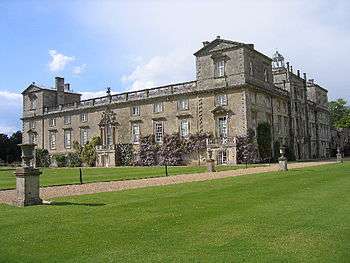Isaac de Caus
| Isaac de Caus | |
|---|---|
| Born |
1590 Dieppe |
| Died |
1648 Paris |
| Nationality | (French) |
| Occupation | Architect |
| Buildings | Wilton House |
Isaac de Caus (1590–1648) was a French landscaper and architect. He arrived in England in 1612 to carry on the work that his brother Salomon de Caus had left behind. He is noted for his work at Wilton House and Lincoln's Inn.
He was the architect in charge of carrying out Inigo Jones's design for Covent Garden.[1]
Biography

Isaac de Caus went in 1612 to England to work his father Salomon de Caus. Instructed in architecture under kings Jacques I and Charles I, by Inigo Jones, Isaac participated in some of Mr. Jones' work. He was employed in the exterior decoration of Gorhambury and Campden House, Kensington. He was responsible for the creation of Wilton House, the country residence of the Earls of Pembroke, built in Venetian style. The design of the property, including two large reception rooms and where - at the time - paintings by Anthony van Dyck to the Earl of Pembroke, was attributed to Inigo Jones, but it is now almost certainly created by Isaac de Caus, who is considered one of the principal architects of the English Baroque.


Isaac de Caus is also known by his book published in London in 1644, folio with figures, titled: "Nouvelle invention de lever l’eau plus haut que sa source, avec quelques machines mouvantes par le moyen de l’eau, et un discours de la conduite d’ycelle" (New invention to lift water higher than its source, with some moving machinery by means of water, and a speech driving ycelle": After a foreword in which the author presents some general concepts, it goes to the Theory of conducting water, part of which contains 19 demonstration proposals, mostly aimed to bring the reader to an understanding of the hydraulic machine which is described. In a very simple construction, this machine, according to the author, "between all pneumatic machines is the one with less force is needed to move more water,", it moves to an height you want, and without the aid of a waterfall. If this machine was running according to forecasts by the inventor, it would do the perpetual motion as resistance to overcome themselves contribute to the production of motion. It is based on the principle of the air compressibility and incompressibility on the water, combined with the atmospheric pressure. At a time when the physical and mechanical sciences were in their infancy, Isaac de Caus was still imbued with the nature's horror of the vacuum. "The water is rising," he writes, "against its usual course to avoid emptiness, which is more repugnant to nature this is not the movement element." Thus all errors found their natural explanation that satisfied the science for a while.
Entitled 'Forces moving', the second part of the 'New invention to lift the water' contains an explanation of twenty-six boards placed at the end of the volume. Isaac de Caus borrows this verbatim from Salomon de Caus most of its problems, such as its birds that are singing, his swan drinking, his owl who is the master of office of chapel, sound Cyclops who plays the flute, its Galatea who walks on water, its clock works and a player that sounds by means of the water, his statue Memnon, etc. He borrows his finest inventions, without quoting, seizing them as their inheritance, as his property. But the problem that was to Solomon de Caus an immortal name - he disdains to reproduce it - he sees only a breeze. He thought, perhaps rightly, that his "machine strong subtille <- SPELLING OF AGE -> to raise a donnante water by means of the sun," had a greater practical value. Also did not he fails to appropriate it. From the discovery and application of the elastic force of the air driven by the heat in the discovery and application of the elastic force of the steam, that there was a similarity distance, d an approximation of an idea. To increase the heat, Salomon de Caus even employed burning mirrors "which, he notes, will cause great heat to water, and by this means it will come out in greater abundance.
"In his foreword, Isaac de Caus tells his readers that he ran a commentary on Archimedes books, but the bibliographers do not talk about this book . Similar to Solomon, Isaac de Caus quoted Du Bartas, calling him a great poet. In this era of religious animosities, judgments, even literary judgements, gave off the prejudices of parties. A Catholic writer would not have quoted the author of the Sepmaine without making any restriction on his praises, and even he would have not mentioned but is not required by the nature of his subject. He appears to have been baptized, on 1 November 1627, at the French Church of Threadneedle Street, he fathered a girl named Suzanne de Caus by his wife Margaret. At his death, he was buried at Pope cemetery of Paris.
References
- Wilton garden: New and rare inventions of waterworks. New York: Garland. 1982. ISBN 9780824001780.
- Strong, Roy C. (1979). The Renaissance garden in England. London: Thames and Hudson. ISBN 9780500012093.
- Harris, John; Tait, A. A. (1979). 'Catalogue of the drawings by Inigo Jones, John Webb, and Isaac de Caus at Worcester College, Oxford. New York: Oxford University Press. ISBN 9780198173625.
- ↑ Summerson, John. Inigo Jones. Penguin, 1966. p. 96. Retrieved 2010-08-23.
Sources
- Haag, E. (1854). La France protestante t III (in French). Librairie Sandoz et Fischbacher., p 278-9.
- Oursel, Noémi-Noire (1886). Nouvelle Biographie normande t. 1 [New Normandy Biography] (in French). Paris: Picard., p. 169.